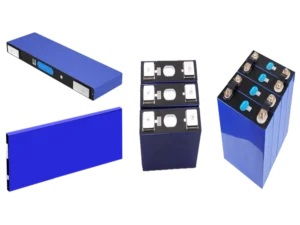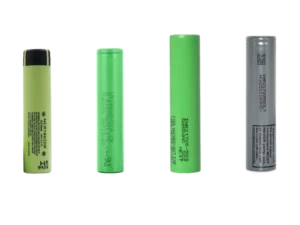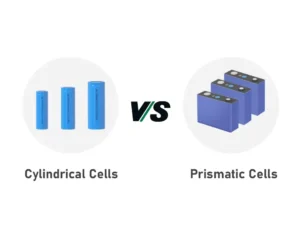Introduction:
The advancement of technology has begun a new era of portable electronic devices. These include electric vehicles and renewable energy solutions. At the heart of these innovations lie rechargeable batteries. They have undergone significant developments.
Among the various types of rechargeable batteries available today, lithium-ion batteries reign supreme. This is due to their high energy density and reliability. Within the realm of lithium-ion batteries, there are two types. These two primary cell designs are prismatic and cylindrical cells. This article will delve into the key differences between these prismatic VS cylindrical cells designs. We will also explore their advantages and disadvantages.
Prismatic Cells: Sleek and Efficient

Prismatic cells, as the name suggests, have a flat, rectangular, or pouch-like shape. They are known for their compact and slim design. It makes them desirable for applications where space efficiency is paramount. These cells have gained significant traction in the consumer electronics industry like in smartphones, laptops, and tablets.
Advantages of Prismatic Cells
- Versatility
One of the key advantages of prismatic cells is their versatility in size and shape. Manufacturers can tailor prismatic cells to fit specific device requirements. It allows for more flexible design options. This adaptability has enabled the development of ever-slimmer and more compact electronic gadgets. And these have now become an integral part of our daily lives.
- Energy Density
Another noteworthy feature of prismatic cells is their superior energy density. This is due to their optimized internal design. And the ability to cut unnecessary packaging. Hence, prismatic cells can offer a higher energy-to-volume ratio in prismatic VS cylindrical cells debate. This means that devices powered by prismatic cells can be smaller. They are also lighter while maintaining longer battery life.
- Better Thermal Management
Moreover, prismatic cells tend to exhibit better thermal management capabilities. Their flat design allows for efficient heat dissipation. It reduces the risk of overheating and enhances safety. It’s important in applications where battery temperature can be a critical factor. For example, in manufacturing electric vehicles (EVs).
Disadvantages of Prismatic Cells
- Costly
However, prismatic cells are not without their drawbacks. One significant limitation is their cost. The manufacturing process for prismatic cells is more complex when we talk about differences in prismatic VS cylindrical cells. It requires higher precision, leading to increased production expenses. Consequently, prismatic batteries are generally more expensive to produce than their cylindrical counterparts.
- Limited Life Span
Additionally, prismatic cells may have a lower cycle life. Their durability compared to cylindrical cells is less. The flat pouch design is more susceptible to damage from physical stress or puncture. It can affect the battery’s overall lifespan and safety.
Cylindrical Cells: The Workhorse of Batteries

Cylindrical cells have been a staple in the battery industry for decades. They are best recognized for their tubular shape. They come in traditional AA or AAA battery types. Cylindrical cells have found widespread use in a wide range of applications. Some examples include flashlights to power tools and electric vehicles.
Advantages of Cylindrical Cells
- Durability
One of the primary advantages of cylindrical cells is their durability and robustness. The cylindrical design, with a protective metal casing, provides excellent resistance. It helps avoid physical damage and punctures. This ruggedness makes cylindrical cells ideal for applications in harsh conditions.
- Economical
Cylindrical cells are also known for their cost-effectiveness. The manufacturing process for cylindrical cells is simpler. Also, it is less intricate, resulting in lower production costs. This affordability has made them the preferred choice for many industries when we compare prismatic VS cylindrical cells. This includes automotive, where large battery packs are required for EVs.
- Extended Life Span
Another crucial feature of cylindrical cells is their relatively long cycle life. These cells tend to exhibit better resilience to repeated charge. Their discharge cycles are longer. This makes them suitable for applications that demand a longer battery lifespan.
Disadvantages of Cylindrical Cells
- Lower Energy Density
Cylindrical cells do have some limitations when we compare cylindrical VS prismatic cells. One of the most notable drawbacks is their lower energy density. The cylindrical design can result in a slightly lower energy-to-volume ratio. It’s because of the inherent empty spaces between cells in a battery pack. This means that devices powered by cylindrical cells may need larger battery packs. It helps to achieve the same level of performance as those using prismatic cells.
- Need More Space
Cylindrical cells may not be as space-efficient as prismatic cells. Their tubular shape can limit design flexibility in certain applications. Particularly in modern, slim electronic devices.
Application Matters: Choosing the Right Cell

The choice between cylindrical VS prismatic cells differs according to application and its requirements. Here are some considerations to help guide your decision:
1. Space Constraints
For devices with limited space, prismatic cells are the better choice. This is due to their flexibility in size and shape.
2. Durability
For applications involving physical stress, cylindrical cells are the safer option. For example, power tools or rugged outdoor equipment.
3. Energy Capacity
If energy is a priority, prismatic cells offer a slight advantage. It makes them suitable for portable electronic devices that demand extended runtimes.
4. Budget
If cost-effectiveness is a primary concern, cylindrical cells are more budget-friendly. It makes them a preferred choice for industries that require large battery packs.
5. Cycle Life
For applications requiring a longer battery lifespan, cylindrical cells are reliable. Examples include applications such as energy storage systems or EVs.
6. Thermal Management
Where efficient heat dissipation is crucial, prismatic cells are better. The reason is their flat design. They can help maintain safe operating temperatures.
Conclusion:
Prismatic and cylindrical cells represent two distinct approaches to lithium-ion battery design. Each has its own set of advantages and disadvantages. Prismatic cells excel in space efficiency, energy density, and thermal management. This makes them ideal for sleek and compact electronic devices. However, in prismatic VS cylindrical cells, cylindrical cells are known for their durability and cost-effectiveness. Their longer cycle life makes them a popular choice in various industries.
Ultimately, the choice should be based on the specific needs of the application. Manufacturers and engineers must carefully consider factors such as size constraints. Also, factors such as durability requirements, energy density, and cost considerations are important. Considering cycle life and thermal management is also important. As battery technology continues to evolve, both designs will find their niche.
